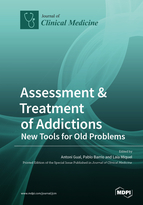Assessment & Treatment of Addictions: New Tools for Old Problems
A special issue of Journal of Clinical Medicine (ISSN 2077-0383). This special issue belongs to the section "Mental Health".
Deadline for manuscript submissions: closed (30 June 2019) | Viewed by 66281
Special Issue Editors
Interests: alcohol treatment; addictions; motivational interviewing; alcohol policy
Special Issues, Collections and Topics in MDPI journals
Interests: addictive behaviors; alcohol dependence; motivational interviewing; cocaine addiction; biomarkers
Special Issues, Collections and Topics in MDPI journals
Special Issue Information
Dear Colleagues,
Addiction in its various forms represents an enormous challenge to society. Worldwide it has been estimated that alcohol, tobacco and illicit drugs were responsible of more than 10 million deaths (Anderson et al, 2018), with a higher impact in developed countries where substance use disorders have been identified as responsible for life expectancy reversals (Rehm et al, 2016).
Societal and medical responses to the problem are far from optimal, but the appearance of new technologies offers room for improvement, and lots of new initiatives have been launched and developed. In this issue we will describe and discuss how these new tools are helping to improve the assessment and treatment of substance use disorders. We will cover a wide diversity of novelties that are being applied in addiction: e-health, APPs, digital phenotyping, ecological momentary assessment and interventions, wearable technology, computer-assisted tests, transcraneal magnetic stimulation and virtual reality are just some examples of what is going on in the field that promises to create a real revolution in the assessment and treatment of addictions.
Anderson P, Gual A, Rehm J. Reducing the health risks derived from exposure to addictive substances. Curr Opin Psychiatry. 2018 Jul;31(4):333-341.
Rehm J, Anderson P, Fischer B, Gual A, Room R. Policy implications of marked reversals of population life expectancy caused by substance use. BMC Med. 2016 Mar 10;14:42
Dr. Antoni Gual
Dr. Pablo Barrio
Dr. Laia Miquel
Guest Editors
Manuscript Submission Information
Manuscripts should be submitted online at www.mdpi.com by registering and logging in to this website. Once you are registered, click here to go to the submission form. Manuscripts can be submitted until the deadline. All submissions that pass pre-check are peer-reviewed. Accepted papers will be published continuously in the journal (as soon as accepted) and will be listed together on the special issue website. Research articles, review articles as well as short communications are invited. For planned papers, a title and short abstract (about 100 words) can be sent to the Editorial Office for announcement on this website.
Submitted manuscripts should not have been published previously, nor be under consideration for publication elsewhere (except conference proceedings papers). All manuscripts are thoroughly refereed through a single-blind peer-review process. A guide for authors and other relevant information for submission of manuscripts is available on the Instructions for Authors page. Journal of Clinical Medicine is an international peer-reviewed open access semimonthly journal published by MDPI.
Please visit the Instructions for Authors page before submitting a manuscript. The Article Processing Charge (APC) for publication in this open access journal is 2600 CHF (Swiss Francs). Submitted papers should be well formatted and use good English. Authors may use MDPI's English editing service prior to publication or during author revisions.
Keywords
- Substance use disorder
- Addiction
- New technologies
- e-health
- m-health
- digital phenotyping
- ecological momentary assessment
- transcraneal magnetic stimulation








